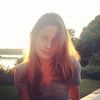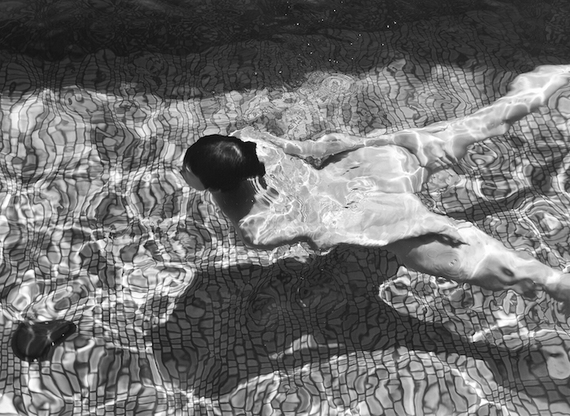For black and white analogue photographer Noah Jashinski, art is a physical manifestation of honesty. In his upcoming exhibition, Seventy-Two Hours, he portrays two parallel cinematic series of raw photographic images. His subjects, two different women, are stripped bare and intimately exposed in a way that would be shocking if it weren't for the innate humility that radiates throughout the work. Stepping into his world, you can feel the adoration in Jashinski's eye as he documents relationships, lust and human nature in their purest forms.
Jeffery: Can you give us a glimpse into your artistic process?
Jashinski: My focus when I walk into any project is building trust and making sure both the subject and I are in a positive mental state. It doesn't matter if I have the best equipment, a huge budget, no restraints, or even the most gorgeous person in the world; if the bond and transparency isn't there, it all becomes meaningless and borders on mundane. Pretty is pretty. There is no escaping that fact, but pretty for the sake of pretty is not only stale, but can almost become new form of "ugliness" because it feels like a lie. If there is no emotional connection or authenticity within the frame, it becomes unattractive, no matter how technically beautiful the location or person may be.
I want to make sure that whatever is being documented is coming from an open, real place. Ultimately, I usually only spend about 25% of the time or less actually shooting; the rest is spent bonding over cigarettes and coffee. Coming from a film background, I have a tendency to treat my camera as though I were filming a documentary. While we talk and throw around ideas, I usually keep the camera peeled to my face and walk around, waiting to be shown what I am not even aware I am looking for. Once I find the angle or the frame I want, I usually set up a tri-pod and proceed to treat the photo more like a painting. We continue to talk and laugh and converse and I just wait for that split second, that exhale, to show itself. It is then I that I will take a single frame, maybe two, and then start the process again. Shooting on film forces me to slow down and treat each shot with care due to its high cost, but I have become accustomed to and now embrace that restriction. It helps filter out the unnecessary.
Jeffery: What was your goal in putting this show together?
Jashinski: Los Angeles is an amazing city for art and culture, but photography, primarily, black and white film photography, is not something generally seen on the front lines as far as galleries and general attention. Outside of select places like Fahey/Klein gallery, finding a home for edgy, unedited photos, is not an easy feat. Whether it is stubborn or not, I refused to present this series if it had to be edited or changed for content. That is why I was so excited and grateful to partner with Art Share L.A. for "Seventy - Two Hours". They not only allowed me to show my work as it was intended to be seen, but they are an amazing non-profit organization that supports youth and the arts. All the standard gallery proceeds, which usually go into someone's pocket, go directly back into their programs.
Jeffery: Is each story of a girl completely different or are they somehow related?
Jashinski: Without a doubt there is a relation between the two vignettes, but I think more than anything, that relationship is coming from me and not from the women. Each of them has their own unique energy, vulnerability and strength that comes through.
Jeffery: Why did you decide to exhibit these two subjects together as one whole?
Jashinski: I chose to exhibit these two women together because I felt there was a certain aesthetic in each that truly exhibits the soul of the project. They are similar enough to not be jarring and seamlessly transition from one story to the next. I think both the woman and the location in each vignette significantly guided the trajectory. Working with Tate is Los Angeles yielded far different results than working with Remy in Oakland and San Francisco. Both women are over a decade apart in age, which I felt projected different stages of a woman's emotion, comfortability, and strength. While in Los Angeles, Tate and I had more control over locations, it being our hometown. Though we primarily improvised and took a very "wing it" approach each day, we still were able to choose where and when we wanted to shoot. With Remy, in Oakland, we were completely at the mercy of the location, the weather and where we were staying. We shot in a loft that I had never seen before. I feel very fortunate to have ended up in the location we did, but I still had far less control. There is experimentation and quietness to the work with Tate. With Remy, there's a sense of strength, sureness and raw emotion.
Jeffery: How do you hope to inspire others through your work?
Jashinski: I hope to inspire other artists, as well as women and people as a whole. On an artistic level, I want to show that you don't need to control and micro-manage every bit of your work. That you can let go and embrace what the world provides. You don't need expensive or equipment or a ton money. If you can build trust and authenticity, especially in collaborating with another person, your work will go further than you could imagine. Also, all of the photos are completely untouched; no photoshopping or retouching. I want everyone to see the beauty in the real and the beauty of imperfections. The texture, movement, and folds of the skin, the strength of presenting yourself to the world as you are and loving yourself for it. I find both these women, in and out, to be some of the most beautiful souls I have ever had the pleasure of knowing. They are both very different body types and have different energies, yet that has no bearing on how uniquely gorgeous they are. That is what I want people to take away from this. The real is beautiful. Morning face can be the most captivating thing you have ever seen. I work a lot with water, whether it be a bathtub or a pool, and I think the reason for this is my desire to wash away all control; wash away the makeup or the hair products. I just want to be left with something and someone who isn't lying to the camera in any way.
Seventy-Two Hours at Art Share LA, Friday, May 22nd, 8:00 pm, 213.687.4278, 801 E. 4th Place, Los Angeles, CA 90013, artsharela.org

